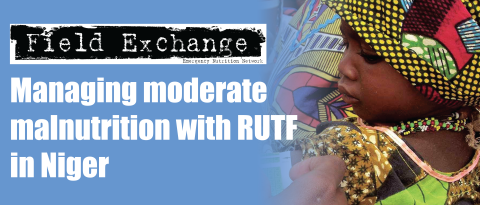Letter on using MUAC v weight-for-height in assessment, by Mark Myatt
Recently, ENN was party to an exchange of questions and discussion between field staff and 'experts' relating to decisions on the use of readymade therapeutic products versus those made from modular ingredients in the management of severe malnutrition. Those involved have agreed to share this exchange with the Field Exchange readership as they feel this is an issue that needs 'airing'. The ENN would welcome contributions from the Field Exchange readership on this topic. Email any comments to marie@ennonline.net (eds).
Questions from the field
Dear Editor,
In Field Exchange 30, Van Herp and others discussed the utility of using Mid Upper Arm Circumference (MUAC) as an assessment tool1. Unfortunately, this article makes the common mistake of treating weight-for-height (W/H) as a 'gold-standard' indicator of nutritional status.
The terms nutritional status and anthropometric status are often used interchangeably. Nutritional status refers to the internal state of an individual as it relates to the availability and utilisation of nutrients at the cellular level. This state cannot be observed directly so observable indicators are used instead. There is a range of observable indicators (biochemical, clinical, and anthropometric) of nutritional status, none of which taken alone or in combination are capable of providing a full picture of an individual's nutritional status. There is, therefore, no 'gold-standard' indicator of nutritional status.
Nutritional status can be usefully defined at the individual, as opposed to the cellular, level as the ratio of nutrient reserves (muscle and fat) to the nutrient requirements of organs (brain, liver, heart, kidneys, lungs, &c.). It is generally recognised that muscle plays a special role as a nutrient reserve during infection and that infection is a major etiological factor in acute undernutrition. W/H expresses the relationship between weight and height. In children, about 4% of weight is nutrient reserves in muscle. About 96% of weight is, therefore, unrelated to nutrient reserves. Height is almost completely unrelated to the nutrient requirements of organs. MUAC, however, is directly related to muscle mass and is, therefore, a direct measure of nutrient reserves.
The limited evidence that is currently available suggests that an index known as the lean-mass ratio (LMR), the ratio of the estimated mass of the limbs to the estimated mass of the trunk, is the best anthropometric indicator of nutritional status. LMR is, however, impractical to collect routinely in developmental and emergency settings. Investigation of the association between LMR and the various anthropometric indicators that are practical to collect in developmental and emergency settings suggests that MUAC, uncorrected for age or height, is a better indicator of nutritional status than all other practical indicators and that W/H is not associated with LMR and is the worst practical indicator of nutritional status.
An alternative to examining the association between different anthropometric indicators of nutritional status is to examine and compare the prognostic value (i.e. of predicting death) of the indicators. When this has been done, W/H has been consistently shown to be least effective predictor of mortality and that MUAC is superior to height-for-age and weight-forage which are both superior to W/H. There is consistent evidence that correcting MUAC for height does not improve its prognostic value.
In terms of indicators that are practical to collect in developmental and emergency settings, uncorrected MUAC has the best claim to being a practicable 'gold-standard' of nutritional status. It is also better than competing indicators in terms of age-independence, precision, accuracy, sensitivity, and specificity. It is also simple, cheap, and acceptable to children and their carers.
The discrepancies between prevalence estimates obtained using W/H and MUAC case-definitions reported by Van Herp and others in Field Exchange 30 have been the subject of study. The currently available evidence suggests that W/H is strongly biased by body shape and, in populations with low sitting height to standing height ratios, its use leads to considerable overestimation (c. 800%) of prevalence in older / taller children. This is consistent with the findings presented by Van Herp and others in Field Exchange 30.
There is now a general acceptance of MUAC as the most useful case definition for entry into therapeutic feeding programmes and MUAC based case definitions are gradually replacing W/H based case-definitions for entry into supplementary feeding programmes (e.g. the national Extended Outreach Strategy (EOS) programme in Ethiopia now uses a MUAC based case-definition to target supplementary rations). The issue of indicator choice for use in surveys intending to estimate the prevalence of acute undernutrition in developmental and emergency settings is not whether MUAC should be used in addition to W/H (since it is now necessary to use MUAC in order to assess need) but whether the use of W/H is useful. The available data suggests that surveys intending to estimate the prevalence of acute undernutrition in developmental and emergency settings could reasonably abandon the use of W/H and use MUAC (and oedema) alone. Such a change would reduce survey costs and allow the use of more informative survey methods (e.g. methods that allowed the mapping of prevalence) at little or no extra cost. Data management and data analysis would be greatly simplified. The unification of definitions of prevalence and need would also simply data-management and data analysis and eliminate the confusion caused by the use of different case definitions.
Mark Myatt
University College London
1Field Exchange 30. Van Herp et al. Can height-adjusted cut-offs improve MUAC's utility as an assessment tool? p23-p26
Imported from FEX website


